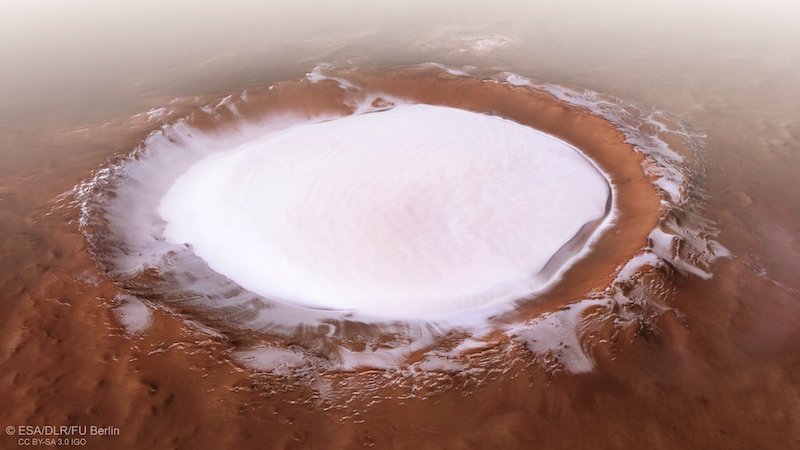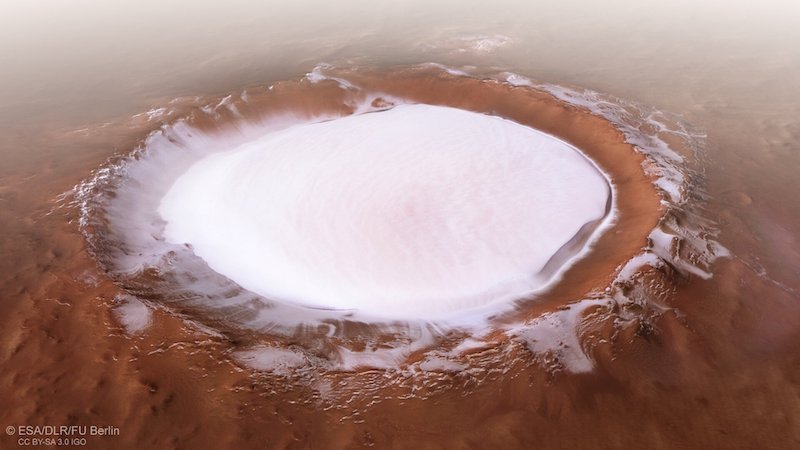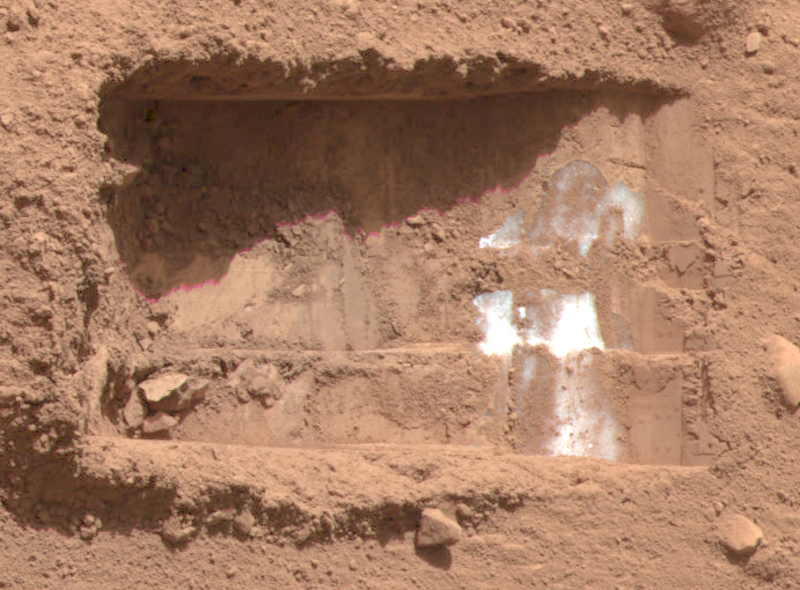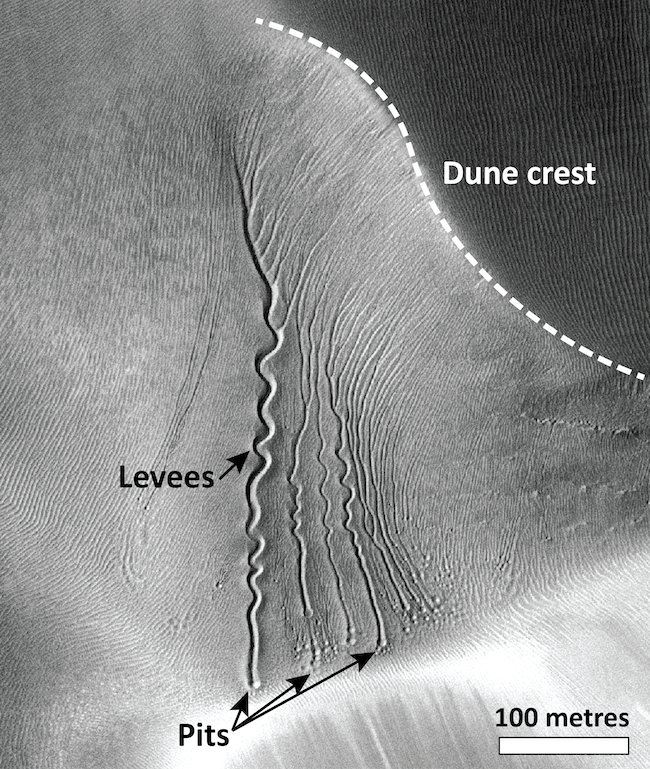Now Reading: New study says microbes on Mars might be living in the ice
-
01
New study says microbes on Mars might be living in the ice
New study says microbes on Mars might be living in the ice


- Could there be microbes living on Mars today? We still don’t know, but it’s possible.
- Ice deposits are the best places to search, a new study from Penn State and Goddard Space Flight Center said.
- Microbes, or at least fragments of dead ones, could be preserved in ice for at least 50 million years.
Living or ancient microbes on Mars?
The search for life on Mars has focused mostly on evidence of past life from billions of years ago. But could there be microbes living on Mars now? If so, the best place to look might be ice, such as in the permafrost and ice caps. That’s what a team of researchers at Penn State and NASA’s Goddard Space Flight Center said on October 15, 2025. The researchers simulated the frozen conditions of Mars in a lab. They found that fragments of biomolecules from ancient microorganisms – or even microbes themselves – could remain preserved for at least 50 million years.
The researchers suggest that future missions to Mars should sample ice deposits instead of just the usual rocks and sand. Notably, the Mars Phoenix lander mission in 2008 did dig up some water ice from just beneath the surface. But Phoenix wasn’t equipped to look for signs of life.
The researchers published their peer-reviewed results in the journal Astrobiology on September 12, 2025.

Evidence of life preserved in ice
To date, searches for past or present life on Mars have been limited to rocks and soil. But is that the best place to look? The new research suggests that future missions should focus on ice instead.
To test this, the researchers suspended and sealed Escherichia coli (E. coli) bacteria in test tubes containing solutions of pure water ice. As a control, they mixed other E. coli samples with water and ingredients found in typical Mars silicate-based rocks and clay.
The researchers wanted to find out how long the bacteria and associated amino acids – the building blocks of proteins – could survive in the ice. They placed the samples in a gamma radiation chamber at Penn State’s Radiation Science and Engineering Center. Then, they cooled the chamber to -60 degrees Fahrenheit (-51 degrees Celsius). That’s the same temperature as typical icy regions on Mars. Next, the researchers blasted the samples with intense radiation that was equivalent to 20 million years’ worth of cosmic ray exposure on Mars.
Finally, they vacuum sealed the samples and sent them to NASA’s Goddard Space Flight Center. There, scientists analyzed the amino acids in the samples. For good measure, they modeled an additional 30 million years of radiation. Altogether then, researchers tested the samples for a total of 50 million years of radiation.
Are There Living Microbes On Mars? Check The Ice.astrobiology.com/2025/10/are-… #astrobiology #Mars #microbiology
— Astrobiology (@astrobiology.bsky.social) 2025-10-17T17:50:03.786Z
Amino acids survive being trapped in ice
The results were surprising. More than 10% of the amino acids survived being trapped in ice and exposed to the radiation for up to 50 million years. Meanwhile, the samples in the water and spoil mixture degraded 10 times faster and didn’t survive. This was similar to another study from 2022. The same group of researchers conducted that study. They found that amino acids preserved in a 10% water ice and 90% Martian soil mixture were destroyed more rapidly than samples containing only sediment.
Lead author Alexander Pavlov at Goddard said:
Based on the 2022 study findings, it was thought that organic material in ice or water alone would be destroyed even more rapidly than the 10% water mixture. So, it was surprising to find that the organic materials placed in water ice alone are destroyed at a much slower rate than the samples containing water and soil.
While in solid ice, harmful particles created by radiation get frozen in place and may not be able to reach organic compounds. These results suggest that pure ice or ice-dominated regions are an ideal place to look for recent biological material on Mars.
Implications for the search for life on Mars
The findings show that traces of microbial life on Mars – either ancient or current – could be found in ice. And there is a lot of ice on the planet. There is, of course a lot of ice at the poles, as well as carbon dioxide ice. And water ice is abundant as permafrost elsewhere on the planet, too. Co-author and professor of geosciences Christopher House at Penn State said:
Fifty million years is far greater than the expected age for some current surface ice deposits on Mars, which are often less than two million years old, meaning any organic life present within the ice would be preserved. That means if there are bacteria near the surface of Mars, future missions can find it.
There is a lot of ice on Mars, but most of it is just below the surface. Future missions need a large enough drill or a powerful scoop to access it, similar to the design and capabilities of Phoenix.
As the paper also notes:
Based on our experiments, locations with pure ice or ice-dominated permafrost would be the best places to look for recently deposited amino acids on Mars and, thus, should be considered as a target sampling location for future Mars missions searching for extant life.

Life under the ice?
Last year, another NASA study also suggested that microbes could live in meltwater pools beneath ice deposits. So if life has ever existed on Mars, looking in ice or below it might offer the best chances of finding it.
There would also potentially still be enough sunlight passing through the translucent ice for photosynthesis to occur.
Europa and Enceladus
In addition, the researchers conducted similar experiments for the icy moons Europa and Enceladus. Both have crusts of ice with liquid water oceans beneath them. On those moons, the temperatures are even colder in the ice. Interestingly, the researchers found that organic molecules would deteriorate even slower than on Mars. That’s good news for NASA’s Europa Clipper mission to Europa, which could possibly detect such organics in the ice, if they exist. Europa Clipper will arrive at Europa in 2030.
Bottom line: If there are any living microbes on Mars, or even dead ones, the best place to search for them is in ice deposits, a new study from Penn State and Goddard Space Flight Center said.
Read more: Rosalind Franklin rover: Finding Mars life might be easy
Read more: SETI’s Nathalie Cabrol on modern-day Mars life, underground
The post New study says microbes on Mars might be living in the ice first appeared on EarthSky.
Stay Informed With the Latest & Most Important News
Previous Post
Next Post
-
 012024 in Review: Highlights from NASA in Silicon Valley
012024 in Review: Highlights from NASA in Silicon Valley -
 02Panasonic Leica Summilux DG 15mm f/1.7 ASPH review
02Panasonic Leica Summilux DG 15mm f/1.7 ASPH review -
 03How New NASA, India Earth Satellite NISAR Will See Earth
03How New NASA, India Earth Satellite NISAR Will See Earth -
 04And Thus Begins A New Year For Life On Earth
04And Thus Begins A New Year For Life On Earth -
 05Astronomy Activation Ambassadors: A New Era
05Astronomy Activation Ambassadors: A New Era -
06SpaceX launch surge helps set new global launch record in 2024
-
 07From Polymerization-Enabled Folding and Assembly to Chemical Evolution: Key Processes for Emergence of Functional Polymers in the Origin of Life
07From Polymerization-Enabled Folding and Assembly to Chemical Evolution: Key Processes for Emergence of Functional Polymers in the Origin of Life




















